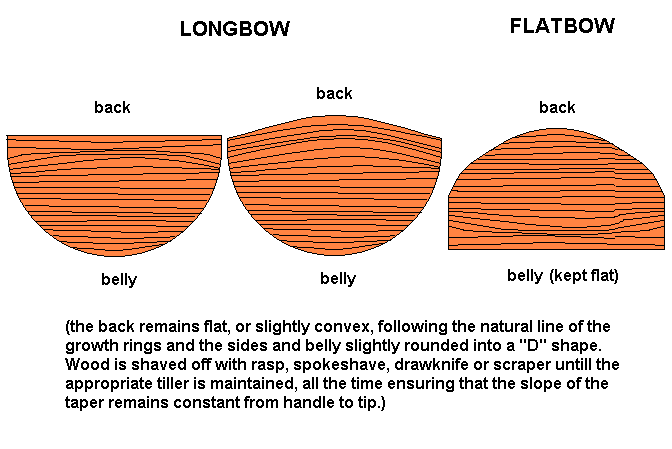
 Tillering
Tillering

Tillering is the process of working a bow down evenly to reach the required draw
weight at the required draw length and to ensure that bow limbs are balanced with
respect to each other and ensuring that the "arc" of the drawn bow is even. The majority
of the work here is simply removing wood from anywhere that is not bending enough,
and *not* removing wood from places that bend too much. The final result is a bow that
bends evenly throughout it's length. (Usually except for the handle section, although in
some bows, even the handle section bends slightly.)
- Initial Process
- Initially, wood is rasped evenly from the length of each limb on the bow. After a
small amount of wood has been removed, rest the end of the limb on the ground,
grasp the other end of the stave in one hand, grasp the center of the bow and press
against the bowgrip. The object is to get the limb starting to flex evenly. Once both
limbs have started to flex about 5-6 inches forward from the vertical, we are ready
to move on to the more precise tillering. Initial nocks are cut 1/2" in from the end of
each limb, sloping at a 45 degree angle from back to belly, using something like a
5/32" circular rasp, pocketknife or 4mm chain saw sharpening file. With practice,
floor testing the bow can be used to get to within 20-30 lb. of the desired weight,
when starting it is advisable to be a bit more cautious. (Floor-testing is resting one
end of the stave on the ground and grasping the handgrip and end of the upper limb.
Putting pressure on the handgrip causes the limb resting on the floor to flex, the
amount of flex is determined by the amount of pressure applied to the handgrip.)
-
- Precise Tillering
- The easiest way of doing this is to have a tiller stick and a pair of bowstrings. The
first bowstring is a very heavy and very long one so the bow can be strung just by
slipping the long string on without flexing the bow. The other bowstring is used
later once the bow starts to flex evenly to about 12" or so.
The other alternative is to have a pulley rigged up in the workshop, so the bow can
be drawn using a pulley and rope with the bow handle clamped down to the floor
or bench, set up so that you can hold the rope and still stand back far enough to
compare the developing curves. With a spring scale, this can also be used to
determine the draw weight of the bow. It is also useful to trace the required curves
on a section of wall or paper such that the developing bow can be compared against
it. As long as both curves are graphed accurately, this helps to ensure that both
limbs match perfectly when they are completed.
Offered by Brian.



![]()
